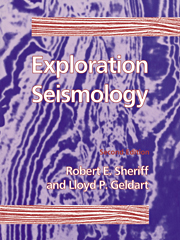Book contents
- Frontmatter
- Contents
- Preface
- Mathematical conventions and symbols
- 1 Introduction
- 2 Theory of seismic waves
- 3 Partitioning at an interface
- 4 Geometry of seismic waves
- 5 Seismic velocity
- 6 Characteristics of seismic events
- 7 Equipment
- 8 Reflection field methods
- 9 Data Processing
- 10 Geologic interpretation of reflection data
- 11 Refraction methods
- 12 3-D Methods
- 13 Specialized techniques
- 14 Specialized applications
- 15 Background mathematics
- Appendices
- Index
8 - Reflection field methods
Published online by Cambridge University Press: 05 June 2012
- Frontmatter
- Contents
- Preface
- Mathematical conventions and symbols
- 1 Introduction
- 2 Theory of seismic waves
- 3 Partitioning at an interface
- 4 Geometry of seismic waves
- 5 Seismic velocity
- 6 Characteristics of seismic events
- 7 Equipment
- 8 Reflection field methods
- 9 Data Processing
- 10 Geologic interpretation of reflection data
- 11 Refraction methods
- 12 3-D Methods
- 13 Specialized techniques
- 14 Specialized applications
- 15 Background mathematics
- Appendices
- Index
Summary
Overview
Field methods for the acquisition of seismic reflection data vary considerably, depending on whether the area is land or marine, on the nature of the geologic problem, and on the accessibility of the area. One of the most important aspects in controlling data costs is avoiding delays such as when some phases of operations have to wait on other phases before work can begin. High-quality field work is essential because nothing done subsequently can remedy defects in the basic data. Evans (1989) and Pritchett (1990) deal with field techniques.
The organizations of field crews who acquire seismic data and procedures for carrying out surveys are described. The common-midpoint (CMP) method is the field method used almost exclusively today. Usually, one wants data to be acquired in the same manner along straight lines so that observed changes in the data may be ascribed to geologic rather than acquisition changes. Practical constraints that restrict acquisition are discussed.
An array of geophones usually feeds each data channel; source arrays are also often used. Arrays have response characteristics that depend on the spectrum and velocity of a wave and the direction from which it comes; these properties are used to attenuate certain types of noise. The selection of field parameters depends on both geologic objectives and noise conditions. Special situations and objectives sometimes require special techniques, such as undershooting, crooked-line, extended resolution, and uphole surveys.
- Type
- Chapter
- Information
- Exploration Seismology , pp. 239 - 274Publisher: Cambridge University PressPrint publication year: 1995
- 1
- Cited by



